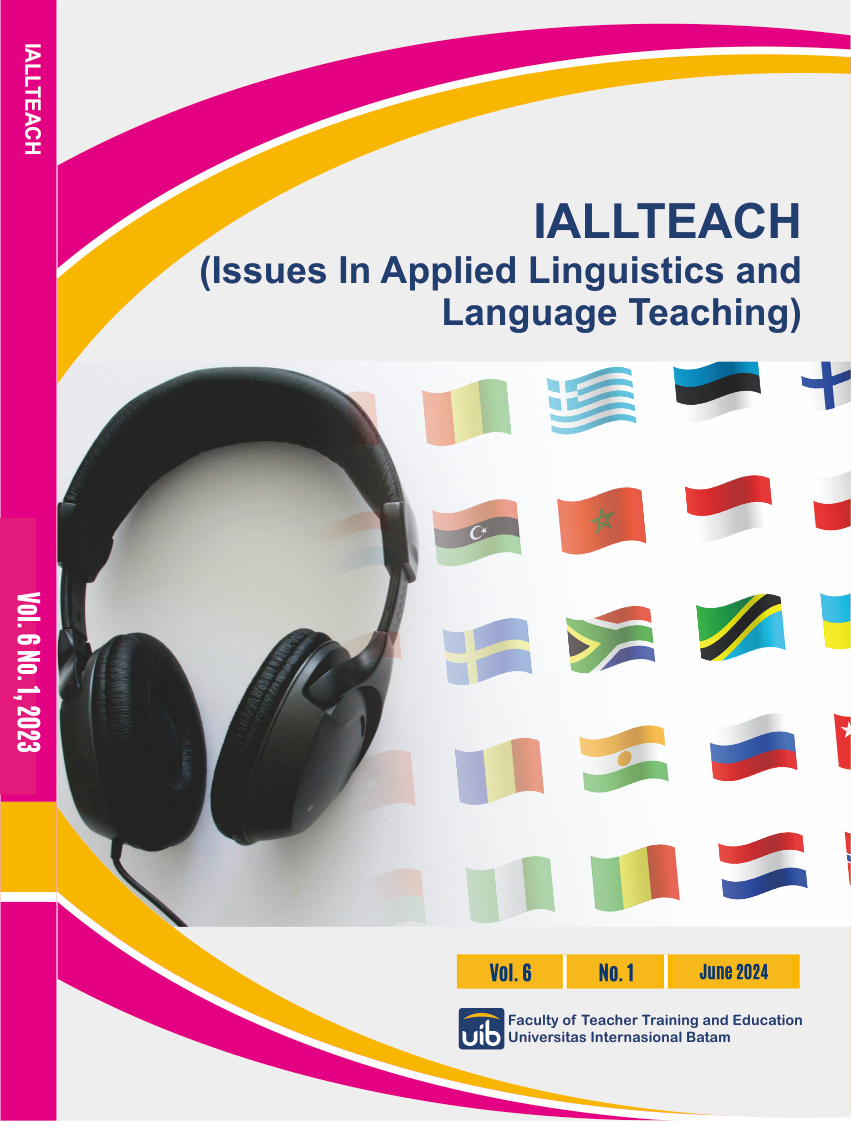Online Paraphrasing Tools in Language Learning: Students’ Perceptions to Overcome the Difficulties in Academic Writing
DOI:
https://doi.org/10.37253/iallteach.v6i1.9325Keywords:
Online Paraphrasing Tools, Academic Writing, Difficulties in Academic WritingAbstract
This research aims to analyze the students' perception of using online paraphrasing tools to overcome their difficulties in academic writing. The participants were 23 university English as a Foreign Language (EFL) students at a Central Java, Indonesia private university. The students were from batches 2019, 2020, and 2021, and they used online paraphrasing tools to help them in their academic writing journey in various academic writing-related classes, such as Academic Writing, Research Design, Research Instrument Design, and Research Report. The data were collected through close-ended questionnaires using the Four-Likert scale (i.e., Strongly Agree, Agree, Disagree, and Strongly Disagree). The data analysis indicated that positive students' perceptions of online paraphrasing tools to overcome the difficulties in their academic writing. Moreover, by applying online paraphrasing tools, students can overcome difficulties in their academic writing. The study also reported students' positive perceptions that using online paraphrasing tools might help to improve their academic writing quality and make them more confident in writing academically.
Downloads
References
Alammar, A., & Amin, E. A.-R. (2023). EFL students' perception of using AI paraphrasing tools in English language research. Arab World English Journal (AWEJ), 14(3), 166-181. https://doi.org/https://dx.doi.org/10.24093/awej/vol14no3.11
Ammyatun, R. L., & Kholis, A. (2023). Can artificial intelligence (AI) like QuillBot AI assist students' writing skills? assisting in learning to write texts using AI. ELE Reviews: English Language Education Reviews, 3(2), 135-154. https://doi.org/ 10.22515/elereviews.v3i2.7533
Chui, H. C. (2022). The Quillbot grammar checker: Friend or foe of ESL student writers? Journal of Creative in Language Learning and Teaching (CPLT), 10(1), 10–31.
Darmalaksana, W. (2017). Panduan publikasi ilmiah: Perangkat aplikasi, standar penulisan dan etika kepengarangan [Guide to scientific publication: Application devices, authorship ethics and standards]. Jurnal Riset dan Inovasi, 2, 24-42.
Fithriani, R. (2021). The Utilization of mobile-assisted gamification for vocabulary. Computer Assisted Language Learning Electronic Journal, 22(3), 146–163.
Fitria, T. N. (2021). QuillBot as an online tool: Students’ alternative in paraphrasing and rewriting English writing. Englisia: Journal of Language, Education, and Humanities, 9. https://doi.org/10.22373/ej.v9i1.10233
Fisher, M. J., & Marshall, A. P. (2009). Understanding descriptive statistics. Australian Critical Care, 22(2), 93–97. https://doi.org/j.aucc.2008.11.003
Hayes, A. (2024). Descriptive statistics: definition, overview, types, and examples. From Investopedia: https://www.investopedia.com/terms/d/descriptive_statistics.asp
Kaur, P., Stoltzfus, J., & Yellapu, V. (2018). Descriptive statistics. International Journal of Academic Medicine, 4(1), 60-63. https://doi.org/ https://www.researchgate.net/publication/327496870
Kurniati, E. Y., & Fithriani, R. (2022). Post-graduate students’ perceptions of Quillbot. JELTL (Journal of English Language Teaching and Linguistics), 7(3). https://doi.org/https://dx.doi.org/10.21462/jeltl.v7i3.852
Lin, L., & Morrison, B. (2021). Challenges in academic writing: Perspectives of Engineering faculty and L2 postgraduate research students. English for Specific Purposes, p. 63. https://doi.org/https://doi.org/10.1016/j.esp.2021.03.004
Mira, A. S., & Fatimah, S. (2020). Students' paraphrased texts and their perceptions of paraphrasing in academic writing. Jurnal Bahasa dan Pembelajaran Bahasa, 14(1), 55-69. https://doi.org/10.24036/ld.v14i1.42494
Mali, Y. C. G. (2022). The exploration of university students’ perceptions of using technology in academic writing classrooms. LLT Journal: A Journal on Language and Language Teaching, 25(1), 107–121. https://e-journal.usd.ac.id/index.php/LLT/article/view/4234
Mali, Y. C. G. (2023). EFL students’ challenges in writing research proposals. LLT Journal: A Journal on Language and Language Teaching, 26(1), 272–289. https://doi.org/10.24071/LLT.V26I1.5296
Mali, Y. C. G., Kurniawan, D., Januardi, J. I., Swara, S. J., Lokollo, N. C. E., Picauly, I. A., Paramitha, N. G., Tanore, J. A., Dewani, M. S., & Pakiding, R. W. (2023). Issues and challenges of technology use in Indonesian schools: Implications for teaching and learning. International Journal of Indonesian Education and Teaching, 7(2), 221–223. https://e-journal.usd.ac.id/index.php/IJIET/article/view/6310
Mulyani, S. (2020). Students’ perception and motivation toward English E-learning during the COVID-19 pandemic (A study of the tenth graders at SMA N 1 Suruh in the academic year of 2019/2020). E-Repository Universitas Islam Negeri Salatiga. http://e-repository.perpus.iainsalatiga.ac.id/8450/
Muslem, A., Yusuf, Y. Q., & Juliana, R. (2018). Perceptions and barriers to ICT use among English teachers in Indonesia. Teaching English with Technology, 18(1), 3–23. https://files.eric.ed.gov/fulltext/EJ1170638.pdf
Nurmayanti, N., & Suryadi. (2023). The effectiveness of using Quillbot in improving writing for students of English education study program. Jurnal Teknologi Pendidikan, 8(1), 32-40. https://e-journal.undikma.ac.id/index.php/jtp/indeks
Pahlevi, M. R. (2020). Student-teachers' engagement in mediated writing feedback: Narrative inquiry. Journal of English Language Teaching and Linguistics, 5(3). https://doi.org/http://dx.doi.org/10.21462/jeltl.v5i3.439
Pujihastuti, I. (2010). Prinsip penulisan kuesioner penelitian. CEFARS: Jurnal Agribisnis dan Pengembangan Wilayah, 2(1), 43-56. https://doi.org/https://jurnal.unismabekasi.ac.id/index.php/cefars/article/view/63
Solanki, A., Kumar, S., & Nayyar, A. (2019). Emerging trends and applications of machine learning. IGI Global. https://doi.org/10.4018/978-1-5225-9643-1
Solanki, A., Kumar, S., & Nayyar, A. (2019). Handbook of research emerging trends and applications of machine learning. IGI Global. https://doi.org/10.4018/978-1-5225-9643-1
Syahnaz, M., & Fithriani, R. (2023). Utilizing artificial intelligence-based paraphrasing tool in EFL writing class: A focus on Indonesian university students' perception. Journal of English Language Teaching, 07(02), 210–218. https://doi.org/https://journal.lppmunindra.ac.id/index.php/SCOPE/




.png)






